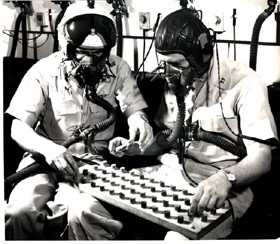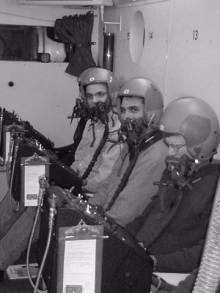Sure, There's A Lot To Learn; But IT Could Save Your Life
by Dean Stevenson, Aviation Lecturer
 (This article, from the online
journal "Aviation & Safety," looks like vital reading to us. We
hope you agree. -- ed.)
(This article, from the online
journal "Aviation & Safety," looks like vital reading to us. We
hope you agree. -- ed.)
Many of you know of the following conditions that could possibly
occur in flight, typically in unpressurized aircraft. They normally
do not affect persons below 10,000 feet (with the exception of
night vision) and as a reminder I refresh your memories to:
Hypoxic Hypoxia which is a reduction in the
amount of oxygen passing into the blood. It is caused by a
reduction in oxygen pressure in the lungs, by a reduced gas
exchange area, exposure to high altitude, or by lung disease. [This
is the hypoxia that is a hazard to aviators.]
Hypemic Hypoxia (Anemic) is defined as a
reduction in the oxygen carrying capacity of the blood. It is
caused by a reduction in the amount of hemoglobin in the blood or a
reduced number of red blood cells. A reduction in the oxygen
transport capacity of the blood occurs through blood donation,
hemorrhage, or anemia. A reduction in the oxygen carrying capacity
of the blood occurs through drugs, chemicals, or carbon monoxide.
[This hypoxia usually experienced by smokers.]
Stagnant Hypoxia is an oxygen deficiency due to
poor circulation of the blood or poor blood flow. Examples of this
condition are high "G" forces, prolonged sitting in one position or
hanging in a harness, cold temperatures, and positive pressure
breathing. [This hypoxia usually experienced when sitting for hours
in a boring class or crunched up on a low altitude long haul
flight.]
Histotoxic Hypoxia is defined as the inability
of the tissues to use oxygen. Examples are carbon monoxide and
cyanide poisoning. Certain narcotics, chewing tobacco, and alcohol
will prevent oxygen use by the tissues. [This hypoxia usually
experienced after drinking too much.] Of course this we know from
basic PPL and CPL information when doing a ground school.
Ischemia is often a age related condition and
if your reader smoked for a number of years, the long term effect
of his smoking career would now manifest itself from a possible
hardening of the arteries or some form of stenosis (chronic
narrowing of a possible supply artery). In short, Ischemia is
insufficient blood flow to provide adequate oxygenation. This, in
turn, leads to tissue hypoxia (reduced oxygen) or anoxia (absence
of oxygen). Ischemia always results in hypoxia; however, hypoxia
can occur without ischemia if, for example, arterial hypoxia
occurs. When the tissue is unable to extract adequate oxygen, the
partial pressure of oxygen within the tissue falls (hypoxia)
leading to a reduction in mitochondrial respiration and oxidative
metabolism.
In a recent study in the states on this very subject, it was
concluded that the Time of Useful Consciousness (TUC) made no
apparent difference between smokers and non-smokers. In fact, the
ability of smokers to perform tasks at certain altitudes sometimes
bettered the non-smokers results.
 In 1997 test results from a series
of experiments showed that Increased levels of carboxyhemoglobin
(COHb) in smokers are blamed for inducing pre-hypoxic tendencies
classified as anemic hypoxia. So it was thought that if COHb can be
simply converted to altitude, there should be significant
differences between smokers and nonsmokers with respect to hypoxia
tolerance. However, the studies of the effects of carbon monoxide
and/or smoking habits on the physiological functions at altitude do
not have consistent conclusions, and many pilots still have smoking
habits. This study was designed to assess whether there was a
definite significant difference for time of useful consciousness,
subjective symptoms, or performance degradation between nonsmokers
and smokers.
In 1997 test results from a series
of experiments showed that Increased levels of carboxyhemoglobin
(COHb) in smokers are blamed for inducing pre-hypoxic tendencies
classified as anemic hypoxia. So it was thought that if COHb can be
simply converted to altitude, there should be significant
differences between smokers and nonsmokers with respect to hypoxia
tolerance. However, the studies of the effects of carbon monoxide
and/or smoking habits on the physiological functions at altitude do
not have consistent conclusions, and many pilots still have smoking
habits. This study was designed to assess whether there was a
definite significant difference for time of useful consciousness,
subjective symptoms, or performance degradation between nonsmokers
and smokers.
The method was, during the hypoxia experience of routine
physiological training, TUC and 12 typical subjective symptoms were
examined at the chamber altitude of 25,000 ft (7620 m) in 589
nonsmokers and 582 smokers in Study 1. The time until the
deterioration of handwriting was assessed by 6 physiological
training observers in 51 nonsmokers and 70 smokers in Study 2. The
results were compared between the groups.
Smokers revealed significantly fewer subjective symptoms in 5
out of 12 symptoms. There were no significant differences in TUC
and the rate of handwriting deterioration between the groups.
And this is the bit that makes you blink, paradoxically, smokers
are slightly resistant to hypoxia with respect to emerging
subjective symptoms. However, bluntness to hypoxia could postpone
the detection of the possible hypoxic So there you have it, the
smoking tendencies more likely "blanked" off the hypoxic awareness.
Now that the reader has stopped his smoking, his body has become
more aware of the symptoms associated with Hypoxia.
In summary, be thankful for two things, one you have stopped
smoking and two, you can recognize the hypoxic symptoms.
 ANN's Daily Aero-Term (04.14.24): Maximum Authorized Altitude
ANN's Daily Aero-Term (04.14.24): Maximum Authorized Altitude ANN's Daily Aero-Linx (04.14.24)
ANN's Daily Aero-Linx (04.14.24) Classic Aero-TV: 'We're Surviving'-- Kyle Franklin Describes Airshow Life 2013
Classic Aero-TV: 'We're Surviving'-- Kyle Franklin Describes Airshow Life 2013 Aero-News: Quote of the Day (04.14.24)
Aero-News: Quote of the Day (04.14.24) Airborne 04.09.24: SnF24!, Piper-DeltaHawk!, Fisher Update, Junkers
Airborne 04.09.24: SnF24!, Piper-DeltaHawk!, Fisher Update, Junkers




